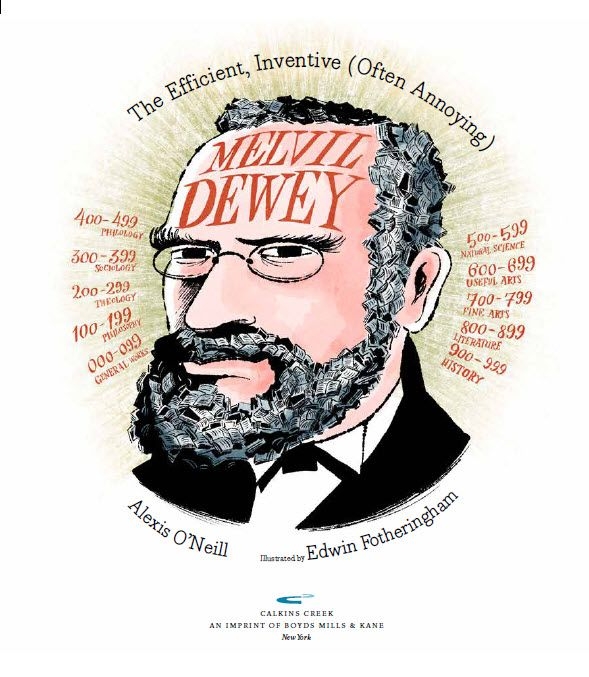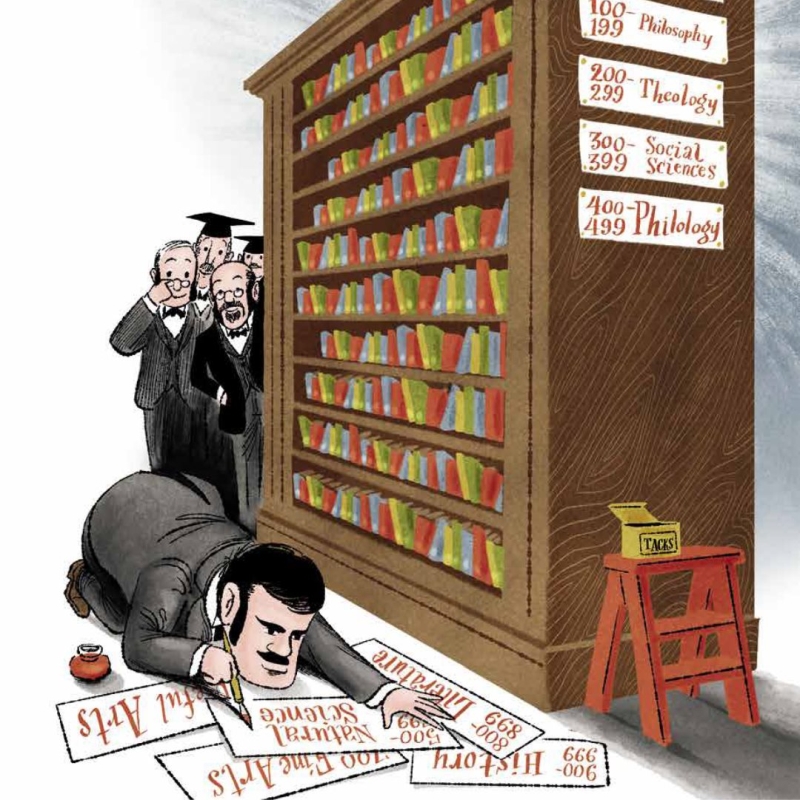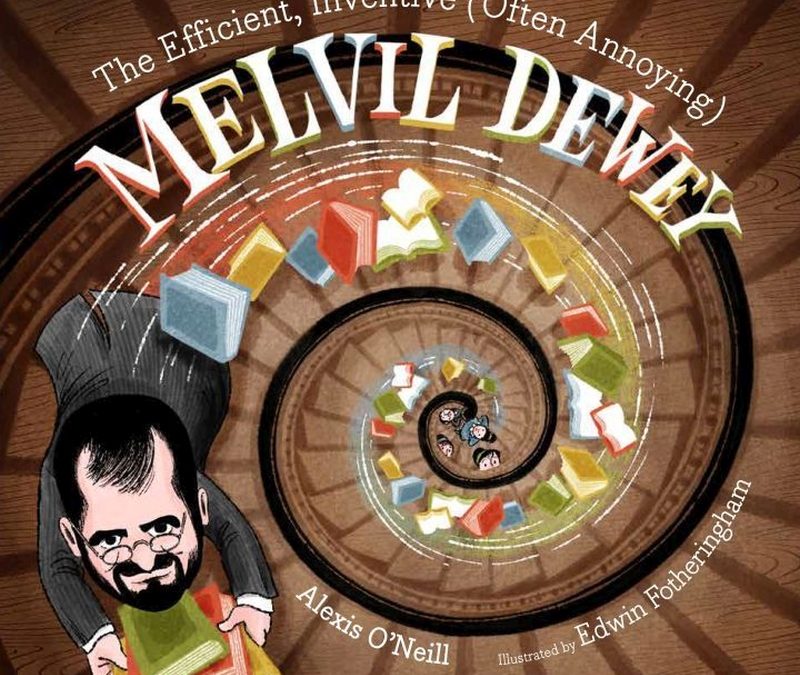“Reading is a mighty engine, beside which steam and electricity sink into insignificance.”—Melvil Dewey
Why this Book? Why will it matter to kids?
Melvil Dewey was at once a mover and a shaker who made lasting improvements and advancements in the world of library science, and a man whose personality and actions ultimately proved to irreparably damage his reputation. It is in the biography of such a person that children can gain insight into the depth of one’s character, the far-reaching effects of one’s’ actions, and the fact that humans, like the most memorable characters in fiction, are multi-faceted beings with a range of admirable qualities and regrettable shortcomings. What we readers do with that knowledge and awareness can help us grow.
Levels and Layers of Learning
Courage, creativity, dedication, diligence, effort, fortitude, humility, inspiration, integrity, justice, passion, perseverance, persistence, perspective, resilience, resourcefulness, respect, self-assurance, self-awareness, self-reliance, tenacity, understanding
English Language Arts, History, Social Studies

Using This Book in the Classroom
Hit the Ground Running
Ready Resources for Educators, Homeschoolers, and Parents
A variety of information related to the book can be found on Alexis O’Neill’s Melvil Resources page.
Because You Asked… An informative look at the making of the book by author Alexis O’Neill, including interesting insight on research
Write Away!
Ideas to prompt writing
Have students close read the text to compile a list of Melvil Dewey’s character traits. Which of these qualities may have helped him in his lifelong accomplishments? Which may have hindered him? Explain. Support opinion with evidence from the text.
Many of the words in the text are bolded in ALL-CAPS. Choose a page and explain why you think specific words are emphasized. How does the book design help you to understand Melvil Dewey’s personality and characteristics?
Throughout the biography and in the back matter, author Alexis O’Neill provides readers with lively anecdotes and a list of Dewey’s inventions and “reform passions.” Ask students to choose one and write about why it stands out.
Compile a list of Melvil Dewey’s accomplishments. Read the Author’s Note to learn of his personal shortcomings. Consider a person you know. Compare positive qualities and faults. Reflect on your own. What can we take away from this biography of Melvil Dewey?

Poetry Break
Related poetry to recite before or following the reading of this book
Poetry breaks fit perfectly into brief moments in the day—from opening or closing the day to lining up for lunch; from zipping up backpacks and jackets to transitioning from one subject to the next. Reading a poem typically takes less than a minute, yet it can introduce or reinforce a concept, celebrate language, exemplify rhythm, enhance vocabulary, expand understanding, increase attention span, initiate reflection, or summon a giggle. And, poetry soothes the spirit.
- Book Speak! Poems About Books by Laura Purdie Salas, illustrated by Josée Bisaillon
- Dictionary For A Better World: Poems, Quotes, and Anecdotes from A to Z by Irene Latham and Charles Waters, illustrated by Mehrdokht Amini
- Good Books, Good Times! selected by Lee Bennett Hopkins, illustrated by Harvey Stevenson
- Jumping Off Library Shelves: A Book of Poems selected by Lee Bennett Hopkins, illustrated by Jane Manning
- Please Bury Me in the Library by J. Patrick Lewis, illustrated by Kyle M. Stone
And Then There’s This…
Enrichment activities, related books, online resources, craft projects, and ideas for further study
Activities for teaching place value and classification related to Dewey Decimal Classification
Can You Crack the Dewey Code? activity sheet
Have students study the title page illustration. Notice how Fotheringham chose to draw Dewey to depict his personality and passions. (Note Dewey’s beard.) Have students draw a friend or relative, incorporating some of the person’s favorite things in the illustration to reflect interests or personality traits.
Find a host of activities based on her other books on Alexis’s website.
Related Books of Interest:
- Bats at the Library by Brian Lies
- Digging for Words: José Alberto Gutiérrez and the Library He Built by Angela Burke Kunkel, illustrated by Paola Escobar
- Down Cut Shin Creek: The Pack Horse Librarians of Kentucky by Kathi Appelt, illustrated by Jeanne Cannella Schmitzer
- The Lady with the Books: A Story Inspired by the Remarkable Work of Jella Lepman by Kathy Stinson, illustrated by Marie Lafrance
- The Librarian of Basra: A True Story from Iraq by Jeanette Winter
- Library Lion by Michelle Knudsen, illustrated by Kevin Hawkes
- Library on Wheels: Mary Lemist Titcomb and America’s First Bookmobile by Sharlee Glenn
- Lost in the Library: A Story of Patience & Fortitude; Where Is Our Library? A Story of Patience & Fortitude by Josh Funk, illustrated by Stevie Lewis
- Miss Moore Thought Otherwise: How Anne Carroll Moore Created Libraries for Children by Jan Pinborough, illustrated by Debby Atwell
- Planting Stories: The Life of Librarian and Storyteller Pura Belpré by Anika Aldamuy Denise, illustrated by Paola Escobar
- Schomburg: The Man Who Built a Library by Carole Boston Weatherford, illustrated by Eric Velasquez
- That Book Woman by Heather Henson, illustrated by David Small
- W Is for Webster: Noah Webster and His American Dictionary by Tracey Fern, illustrated by Boris Kulikov
- Waiting for the Biblioburro by Monica Brown, illustrated by John Parra
Meet the Author

Photo Credit: A. Boeshaar
Backstory: Q & A with Alexis O’Neill
I have known Alexis for years and have long admired her books. The message in the classic Recess Queen continues to resonate. Special to my heart is The Kite That Bridged Two Nations: Homan Walsh and the First Niagara Suspension Bridge which is set in Niagara Falls where I grew up. Alexis generously gave of her time to respond to a few questions about the creation of hew newest book, The Efficient, Inventive (Often Annoying) Melvil Dewey, named to Junior Library Guild’s Fall 2020 list, and her career revolving around books and bringing them to children.
Judy Bradbury: How did you come to write The Efficient, Inventive (Often Annoying) Melvil Dewey? What kernel seeded its creation?
Alexis O’Neill: A librarian friend sent me a goofy video made to teach kids the Dewey Decimal Classification system (DDC) in 2010. I realized that I knew nothing about the guy who invented it although I had used it all my life. As I began researching Dewey, I found out he had once lived with his family in Oneida, New York, a place where I taught elementary school. Who knew! (I wish I had saved the link to that DDC video!)
JB: Tell about one hurdle you experienced in the creation of The Efficient, Inventive (Often Annoying) Melvil Dewey or provide a memorable (or humorous!) anecdote related to the making of this book.
AO: Sometimes a research question, one that I know is interesting but not necessary for the narrative in the book, becomes an itch that just needs scratching!
A small detail in the book is about how Dewey walked 10 miles as a boy from Adams Center to Watertown, NY to buy the 1864 edition of Webster’s Unabridged Dictionary of American English (the illustrated edition) with his chore money. I wanted to know the dimensions of the book, including how heavy it was. I searched the New York State Archives, but they didn’t have the exact edition. The Merriam-Webster Company had a copy, but because of the pandemic, no one could get into the archives to do measurements. I finally located a copy at my alma mater, Syracuse University’s Special Collections Center and a kind librarian sent me the stats (8” W x 10.5” L x 4” D and 7 lbs 5 oz – the average birth weight of a newborn baby!)
JB: What did you learn from creating The Efficient, Inventive (Often Annoying) Melvil Dewey?
AO: Dewey wasn’t a one-and-done kind of creative person. I was surprised at how driven Dewey was from a very young age. Even as a teen, he seriously reflected on what he could do to make a difference in the world. Not only did he create the Dewey Decimal Classification system that organized books for easier public access, but he created a school for librarians and invented tools to make their jobs more efficient. And that was just a start.
JB: What would surprise readers to learn about you or about the creation of The Efficient, Inventive (Often Annoying) Melvil Dewey?
AO: I wrote my first draft in April 2010 and kept refining it in my writers’ groups. But in 2015, I saw an announcement that a well-known author received a contract for a Dewey picture book. Up until that time, there had not been a picture book biography of Dewey. Discouraged, I gave up. I put my manuscript away for a year. But I revived, submitted my manuscript, and sold it in 2017. The other book never came out.
JB: How do you see The Efficient, Inventive (Often Annoying) Melvil Dewey connecting to curriculum?
AO: I see Melvil Dewey as a great way for librarians to introduce kids to the DDC – the human story of why it was invented in the first place. This book gives kids insight into how we create systems to organize information so that it can be catalogued and accessed easily. Kids can be encouraged to see organizational systems not only in science, technology, engineering, and mathematics, but also in their own everyday life at home or in school.
JB: One of the themes in The Efficient, Inventive (Often Annoying) Melvil Dewey is that a person can have admirable qualities as well as decidedly not-so-admirable qualities. How did you determine what to emphasize about his character in portraying Melvil Dewey in this picture book biography?
AO: I was surprised to learn that Dewey was an anti-Semite and had extreme prejudices of people of other religious and racial groups, excluding them from membership in his Lake Placid Club. He also sexually harassed women. These behaviors led to him losing his positions and his reputation later in his career.
Kids deserve to know that people who are put on pedestals by admirers aren’t without faults. They need to know that someone can do good things and not be a good person, or take actions or engage in activities that later mar their accomplishments. (Think: Thomas Jefferson enslaving people). The decision an author has to make is how to address this in books for children. I chose to have the main narrative focus on his contributions and to address the rest in the back matter, showing how Dewey’s behavior led to serious consequences.
JB: What do you hope readers will take away from The Efficient, Inventive (Often Annoying) Melvil Dewey?
AO: I hope they see that a passion to make a difference in the world can be a good thing and bring about significant changes – that you are never too young to have big ideas.
JB: What is one question you wish I had asked, and what is your answer?
AO: You have written three picture books about important figures from New York State. What thread ties them together?
Answer: I didn’t realize until just recently that the thread of immigration runs through them all. In The Kite That Bridged Two Nations, Homan Walsh was an immigrant from Ireland. In Jacob Riis’s Camera: Bringing Light to Tenement Children, Jacob Riis was an immigrant from Denmark who wanted to shed light on the terrible living conditions immigrants endured in the Lower East Side of New York City. And in The Efficient, Inventive (Often Annoying) Melvil Dewey, Dewey championed the use of public libraries to educate newly arriving immigrants. Because all of my grandparents were immigrants to America – one set from Canada, the other from Ireland – I guess you could say that’s been a thread throughout my life, too.
JB: What’s next?
AO: I’ve been recording presentations for kids and teachers and have some virtual school visits lined up. I can’t wait to see everyone again in-person! And of course, I’m always working on the next book.

About the Illustrator
Over to You…
What picture book biography intended for older elementary grade students do you recommend?
News & Updates
Check out author Jason Reynolds’ “Write. Right. Rite.” video series in which the National Ambassador for Young People engages young writers with short, entertaining spots “all about learning the ritual of ‘authentic’—not to be confused with ‘correct’ or ‘exact’—expression.” Each segment ends with a writing prompt that former National Ambassador for Young People Kate DiCamillo has called “amazing…Those prompts open doors.”
Also, Jason Reynolds’ Printz Honor, Newbery Honor, and otherwise much-honored novel Long Way Down, has been adapted into a graphic novel with stunning, often heart-stopping art by Danica Novgorodoff. Grades 7-up.
Jerry Craft’s graphic novel Class Act, the companion to the Newbery Award and Coretta Scott King Author Award-winning New Kid, has released to rave reviews. Find an interview with Jerry and resources for using New Kid with middle schoolers here on this blog.
Final Thought
“I have always imagined that Paradise will be a kind of library.” ~ Jorge Luis Borges

